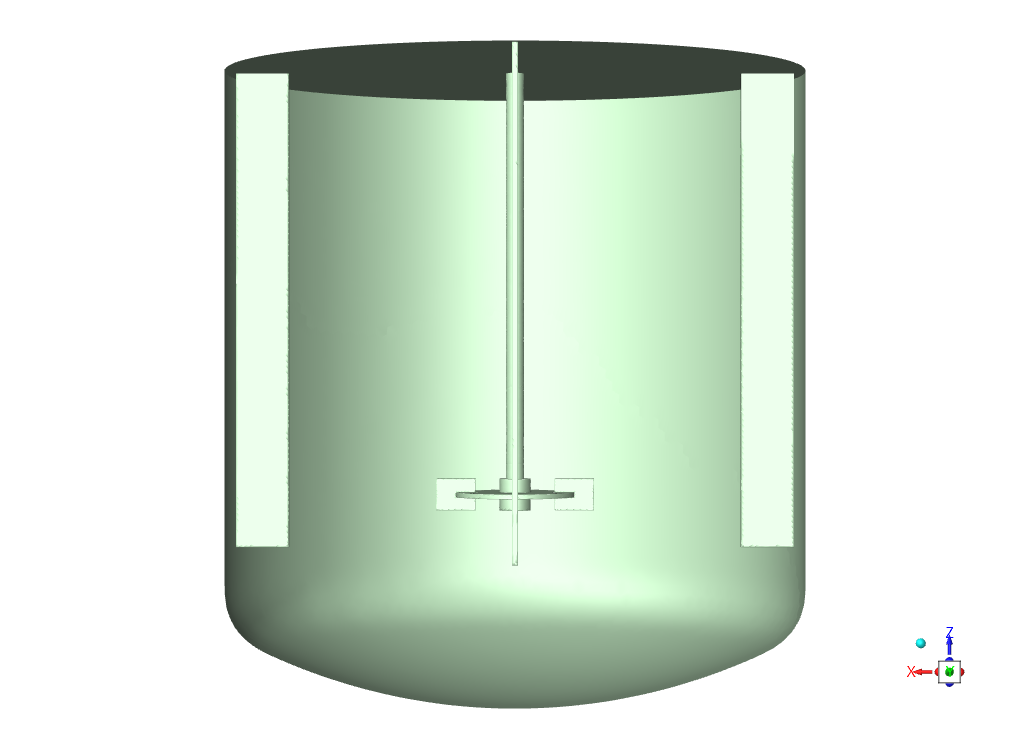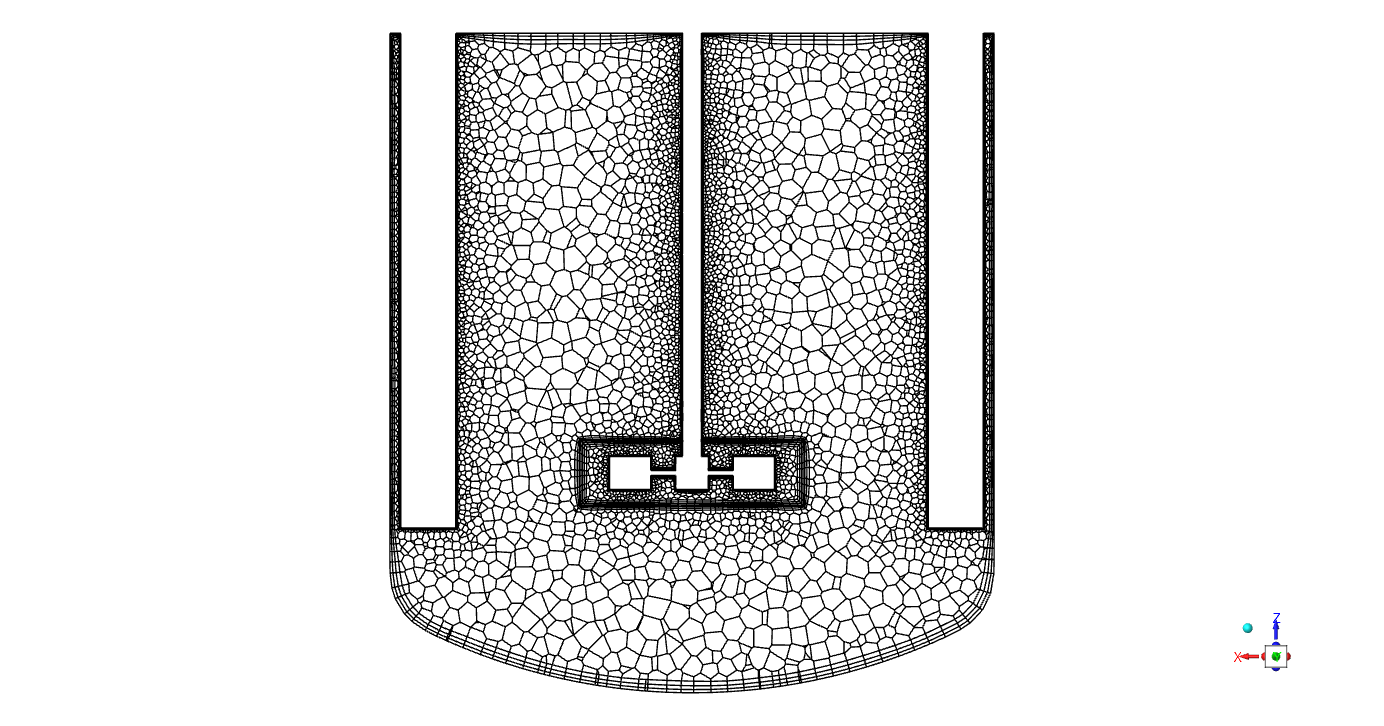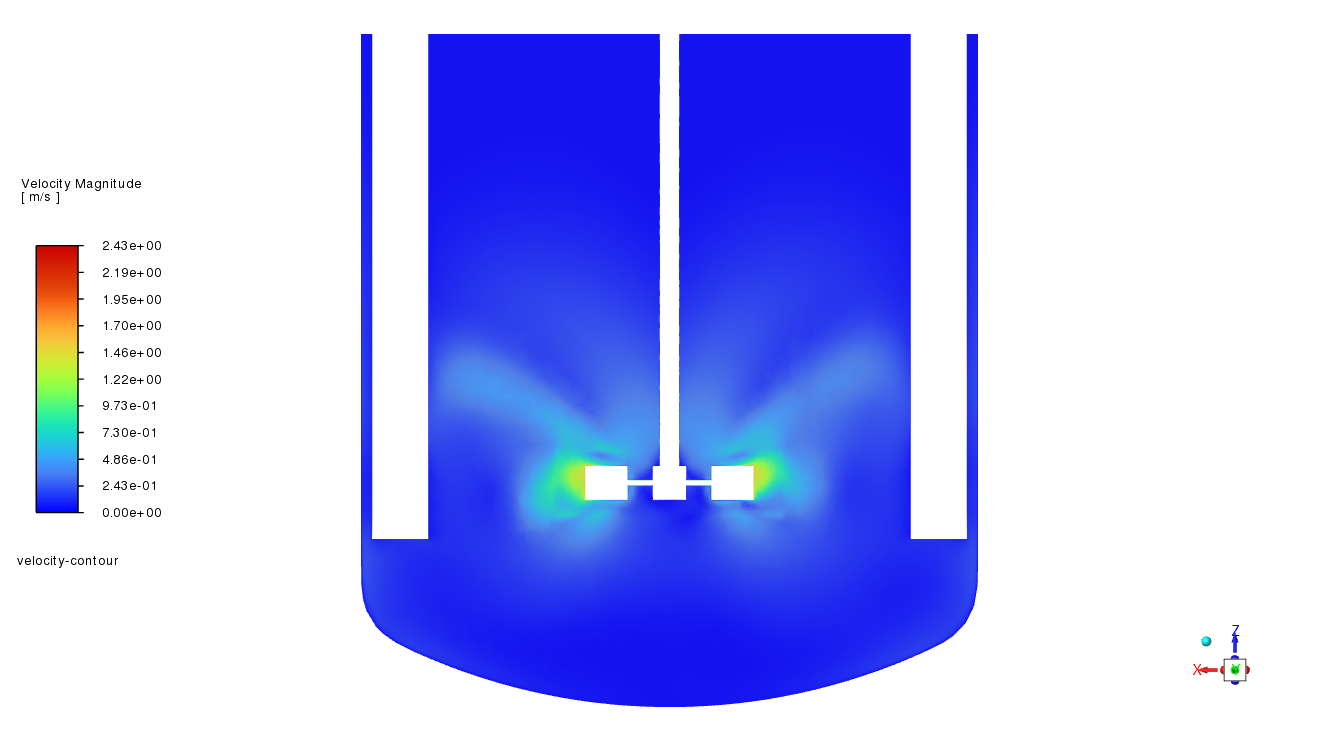Note
Go to the end to download the full example code.
Mixing Tank Workflow#
Overview#
The mixing tank workflow demonstrates basic end to end comprehensive solution for simulating mixing tank with an single impeller. This workflow also demonstrates the use of the Python API’s capabilities to setup complex workflows.
Mixing tanks are commonly used in industries such as chemical processing, food and healthcare, pharmaceuticals etc. The mixing tank workflow in ANSYS Fluent allows engineers to analyze the performance of mixing tanks, optimize the design of impellers, and understand the flow patterns within the tank. By simulating the mixing process, engineers can gain insights into the efficiency of mixing, blend time, the distribution of shear forces, and the overall performance of the mixing system.
This workflow can be extended to design and develop the vertical application for non-experts and seemingly expose the required functionality to democraticize the simulation process.
The workflow includes:
Importing a geometry file
Generating the mesh
Setting up the solver
Defining the materials
Defining the cell zones and wall boundary conditions
Setting up the solution methods and controls
Defining the report definitions
Running the solver
Post-processing the results
Saving the case file
Closing the session

Import required libraries/modules#
import fnmatch
import os
import platform
import ansys.fluent.core as pyfluent
from ansys.fluent.core import examples
Launch Fluent session with meshing mode and print Fluent version#
session = pyfluent.launch_fluent(
mode="meshing",
cleanup_on_exit=True,
)
print(session.get_fluent_version())
Meshing Workflow#
workflow = session.workflow
filenames = {
"Windows": "mixing_tank_geom.dsco",
"Other": "StirredTank.scdoc.pmdb",
}
geometry_filename = examples.download_file(
filenames.get(platform.system(), filenames["Other"]),
"pyfluent/examples/MixingTank-WorkFlow",
save_path=os.getcwd(),
)
workflow.InitializeWorkflow(WorkflowType="Watertight Geometry")
workflow.TaskObject["Import Geometry"].Arguments = dict(FileName=geometry_filename)
workflow.TaskObject["Import Geometry"].Execute()
workflow.TaskObject["Generate the Surface Mesh"].Execute()
workflow.TaskObject["Describe Geometry"].Arguments = dict(
SetupType="The geometry consists of only fluid regions with no voids",
wall_to_internal="Yes",
InvokeShareTopology="Yes",
)
workflow.TaskObject["Describe Geometry"].Execute()
workflow.TaskObject["Apply Share Topology"].Execute()
workflow.TaskObject["Update Boundaries"].Execute()
workflow.TaskObject["Update Regions"].Execute()
workflow.TaskObject["Add Boundary Layers"].InsertCompoundChildTask()
workflow.TaskObject["smooth-transition_1"].Execute()
workflow.TaskObject["Generate the Volume Mesh"].Execute()
# Write a mesh file for reference
session.tui.file.write_mesh("mixing_tank.msh.h5")
Switch to the Solver Mode#
solver_session = session.switch_to_solver()
Display the mesh in solver mode#
# Create a middle plane to display the mesh
y_mid_plane = solver_session.settings.results.surfaces.plane_surface.create(
name="mid_plane"
)
y_mid_plane.method = "zx-plane"
y_mid_plane.y = 0
y_mid_plane.display()
# Access the graphics object
graphics = solver_session.settings.results.graphics
# Set the hardcopy format for saving the image
graphics.picture.driver_options.hardcopy_format = "png"
# View settings
geom_view = graphics.views.display_states.create("geom_view")
geom_view.front_faces_transparent = "enable"
geom_view.view_name = "top"
# Get the list of all walls
all_walls = solver_session.settings.setup.boundary_conditions.wall.get_object_names()
filtered_walls_to_display = [wall for wall in all_walls if "mrf" not in wall]
# Create a mesh object and configure its settings
mesh_object = solver_session.settings.results.graphics.mesh.create(name="mesh-1")
mesh_object.surfaces_list = filtered_walls_to_display
mesh_object.options.edges = False
mesh_object.display_state_name = geom_view.name()
mesh_object.coloring.option = "manual"
mesh_object.display()
graphics.views.auto_scale()
graphics.picture.save_picture(
file_name="mixing_tank_geom_view.png",
)
mesh_object.surfaces_list = y_mid_plane.name()
mesh_object.options.edges = True
mesh_object.display()
graphics.views.auto_scale()
graphics.picture.save_picture(
file_name="mixing_tank_mesh.png",
)
geom_view.front_faces_transparent = "disable"

g = 9.81 # m/s^2
water_density = 1000.0 # kg/m^3
water_viscosity = 0.001 # kg/m-s
agitation_speed = 10 # rad/s
Solver Setup and Solve Workflow#
solver_session.settings.setup.general.operating_conditions.gravity.enable = True
solver_session.settings.setup.general.operating_conditions.gravity.components = [
0.0,
0.0,
-g,
]
Define Materials#
solver_session.settings.setup.materials.database.copy_by_name(
type="fluid", name="water-liquid"
)
fluid_mat = solver_session.settings.setup.materials.fluid["water-liquid"]
fluid_mat.density.value = water_density
fluid_mat.viscosity.value = water_viscosity
Define Cell Zones, Wall Boundary Conditions#
# Get the list of all Fluid Cell Zones,
fluid_cell_zones = (
solver_session.settings.setup.cell_zone_conditions.fluid.get_object_names()
)
fluid_mrf_cell_zones = [zone for zone in fluid_cell_zones if "mrf" in zone]
for cell_zone in fluid_mrf_cell_zones:
print(cell_zone)
# Set the material for each cell zone
fluid_cell_zone = solver_session.settings.setup.cell_zone_conditions.fluid[
cell_zone
]
fluid_cell_zone.general.material = "water-liquid"
# Set the reference frame for each cell zone
fluid_cell_zone.reference_frame.reference_frame_axis_origin = [0, 0, 0.4]
fluid_cell_zone.reference_frame.reference_frame_axis_direction = [0, 0, -1]
fluid_cell_zone.reference_frame.frame_motion = True
# Set the rotation speed for each cell zone
fluid_cell_zone.reference_frame.mrf_omega.value = agitation_speed
stationary_cell_zones = [zone for zone in fluid_cell_zones if "mrf" not in zone]
stationary_cell_zones = solver_session.settings.setup.cell_zone_conditions.fluid[
stationary_cell_zones[0]
]
stationary_cell_zones.general.material = "water-liquid"
# Wall boundary conditions
wall_shaft = [wall for wall in all_walls if "shaft" in wall]
for wall in wall_shaft:
print(wall)
wall_boundary = solver_session.settings.setup.boundary_conditions.wall[wall]
wall_boundary.momentum.wall_motion = "Moving Wall"
wall_boundary.momentum.relative = False
wall_boundary.momentum.rotating = True
wall_boundary.momentum.rotation_axis_direction = [0, 0, -1]
wall_boundary.momentum.rotation_speed = agitation_speed
liquid_level_bc = solver_session.settings.setup.boundary_conditions.wall[
"wall_liquid_level"
]
liquid_level_bc.momentum.wall_motion = "Stationary Wall"
liquid_level_bc.momentum.shear_condition = "Specified Shear"
# Change the Zone type for internal walls to interior
solver_session.setup.boundary_conditions.set_zone_type(
zone_list=["fluid_mrf_1-fluid_tank"], new_type="interior"
)
Solution Methods and Controls#
solver_session.settings.solution.methods.p_v_coupling.flow_scheme = "SIMPLE"
solver_session.settings.solution.methods.spatial_discretization.discretization_scheme[
"pressure"
] = "presto!"
solver_session.settings.solution.controls.under_relaxation["pressure"] = 0.5
solver_session.settings.solution.controls.under_relaxation["mom"] = 0.3
solver_session.settings.solution.controls.under_relaxation["k"] = 0.6
solver_session.settings.solution.controls.under_relaxation["omega"] = 0.6
solver_session.settings.solution.controls.under_relaxation["turb-viscosity"] = 0.6
Residuals Criteria & Initialization#
# Residuals criteria
residuals_options = solver_session.settings.solution.monitor.residual
residuals_options.equations["continuity"].absolute_criteria = 0.0001
residuals_options.equations["continuity"].monitor = True # Enable continuity residuals
residuals_options.equations["x-velocity"].absolute_criteria = 0.0001
residuals_options.equations["y-velocity"].absolute_criteria = 0.0001
residuals_options.equations["z-velocity"].absolute_criteria = 0.0001
residuals_options.equations["k"].absolute_criteria = 0.0001
residuals_options.equations["omega"].absolute_criteria = 0.0001
# Initialize the solution
initialization = solver_session.settings.solution.initialization
initialization.reference_frame = "absolute"
initialization.initialization_type = "standard"
initialization.standard_initialize()
Define Report Definitions#
# Create a report definition for the volume average velocity magnitude
volume_avg_vmag_report_def = (
solver_session.settings.solution.report_definitions.volume.create("volume-avg-vmag")
)
volume_avg_vmag_report_def.report_type.allowed_values() # output the allowed values for report type
volume_avg_vmag_report_def.report_type = "volume-average"
volume_avg_vmag_report_def.field = "velocity-magnitude"
volume_avg_vmag_report_def.cell_zones = fluid_cell_zones
# Report plot
volume_avg_vmag_report_plot = (
solver_session.settings.solution.monitor.report_plots.create(
"volume-avg-vmag-rplot"
)
)
volume_avg_vmag_report_plot.report_defs = "volume-avg-vmag"
# Report file
volume_avg_vmag_report_file = (
solver_session.settings.solution.monitor.report_files.create(
"volume-avg-vmag-rfile"
)
)
volume_avg_vmag_report_file.report_defs = "volume-avg-vmag"
# Create a report definition for the torque on the impeller walls
torque_report_def = solver_session.settings.solution.report_definitions.moment.create(
"torque_imp_walls"
)
torque_report_def.report_output_type.allowed_values() # output the allowed values for report output type
torque_report_def.report_output_type = "Moment"
filtered_walls = fnmatch.filter(all_walls, "wall_impeller*")
torque_report_def.zones = filtered_walls
# Report plot
torque_report_plot = solver_session.settings.solution.monitor.report_plots.create(
"torque_imp_walls_rplot"
)
torque_report_plot.report_defs = "torque_imp_walls"
# Report file
torque_report_file = solver_session.settings.solution.monitor.report_files.create(
"torque_imp_walls_rfile"
)
torque_report_file.report_defs = "torque_imp_walls"
# Average and maximum dissipation rate report definitions
average_dissipation_rate_report_def = (
solver_session.settings.solution.report_definitions.volume.create(
"average-dissipation-rate"
)
)
average_dissipation_rate_report_def.report_type = "volume-average"
average_dissipation_rate_report_def.field = "turb-diss-rate"
average_dissipation_rate_report_def.cell_zones = fluid_cell_zones
maximum_dissipation_rate_report_def = (
solver_session.settings.solution.report_definitions.volume.create(
"maximum-dissipation-rate"
)
)
maximum_dissipation_rate_report_def.report_type = "volume-max"
maximum_dissipation_rate_report_def.field = "turb-diss-rate"
maximum_dissipation_rate_report_def.cell_zones = fluid_cell_zones
# Average and maximum strain rate report definitions
average_strain_rate_report_def = (
solver_session.settings.solution.report_definitions.volume.create(
"average-strain-rate"
)
)
average_strain_rate_report_def.report_type = "volume-average"
average_strain_rate_report_def.field = "strain-rate-mag"
average_strain_rate_report_def.cell_zones = fluid_cell_zones
maximum_strain_rate_report_def = (
solver_session.settings.solution.report_definitions.volume.create(
"maximum-strain-rate"
)
)
maximum_strain_rate_report_def.report_type = "volume-max"
maximum_strain_rate_report_def.field = "strain-rate-mag"
maximum_strain_rate_report_def.cell_zones = fluid_cell_zones
Run Solver#
# Run the calculation
run_calculation = solver_session.settings.solution.run_calculation
run_calculation.iter_count = 500
# Write the case file
solver_session.settings.file.write(
file_type="case", file_name="mixing_tank_final.cas.h5"
)
# Run the calculation
run_calculation.calculate()
Post-Processing Workflow#
# Set View
contour_view = graphics.views.display_states.create("contour_view")
contour_view.front_faces_transparent = "disable"
contour_view.view_name = "top"
# Define the contour for velocity magnitude
velocity_contour = solver_session.settings.results.graphics.contour.create(
name="velocity-contour"
)
velocity_contour.field = "velocity-magnitude"
velocity_contour.surfaces_list = ["mid_plane"]
velocity_contour.display_state_name = contour_view.name()
velocity_contour.display()
graphics.views.auto_scale()
graphics.picture.save_picture(file_name="mixing_tank_velocity_contour.png")

Save the case file#
solver_session.settings.file.write(
file_type="case-data", file_name="mixing_tank_final.cas.h5"
)
Close the session#
session.exit()
